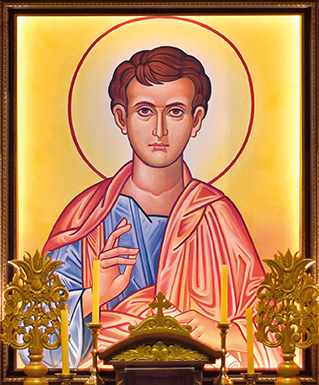
Thomas the Apostle
Thomas the Apostle also called Didymus ("twin"), was one of the Twelve Apostles of Jesus according to the New Testament. Thomas is commonly known as "Doubting Thomas" because he doubted Jesus' resurrection when first told of it (as related in the Gospel of John alone); later, he confessed his faith, "My Lord and my God," on seeing Jesus' crucifixion wounds.
According to traditional accounts of the Saint Thomas Christians of modern-day Kerala in India, Thomas is believed to have travelled outside the Roman Empire to preach the Gospel, travelling as far as the Malabar Coast which is in modern-day Kerala. According to their tradition, Thomas reached Muziris (modern-day North Paravur and Kodungalloor in the state of Kerala, India) in AD 52.In 1258, some of the relics were brought to Ortona, in Abruzzo, Italy, where they have been held in the Church of Saint Thomas the Apostle. He is often regarded as the patron saint of India,
According to legend, Saint Thomas, one of the twelve disciples of Jesus, arrived at Muziris in present-day Kerala state in India from the Roman province of Judea in 52 CE and preached between 52 CE and 72 CE, when he was martyred on St. Thomas Mount.[1]
It is claimed that St Thomas' apostolic ministry in India took place specifically at Cranganore along the Malabar coast from 52 CE to 68 CE. His journey through Kerala is said to have resulted in numerous conversions. After spending 10 years on the Malabar coast he is said to have travelled Eastwards across the Deccan Plateau, arriving in Mylapore in 68 CE. The cave at the little mount is claimed to be his favourite preaching spot. A 2000-year-old, never-drying, miraculous stream of water on a rock face are said to be examples of the apostle's divine exploits. A church atop St. Thomas mount was built by the Portuguese in 1547 to mark the spot. It was on this St. Thomas Mount that the apostle was said to be killed by a lance which pierced through his back.
His mortal remains were believed to be buried in the location over which the present day Santhomes Cathedral Basilica stands. Sometime in the 10th century CE a group of Nestorian Christians from Persia founded the Christian village of San Thomes and proceeded to build a church over the burial site of St. Thomas. This structure fell to ruins between the 14th and 15th centuries. In 1522 the Portuguese moved the apostle's remains to a new tomb and church which attained the status of Cathedral in 1606.
Pope Pius XII honoured the Cathedral Church of the Roman Catholic Archdiocese of Madras and Mylapore, raising it to the rank of Minor Basilica by an apostolic brief dated 16 March 1956. Massive followings and the immense devotion of people to a very ancient image of the Blessed Virgin also known as “Our Lady of Mylapore” were among the motives that prompted the Pope to bestow this honour.
There was 118 years of insecurity and uncertainty from the time the Golconda’s occupied San Thome in 1662 to 1780. No considerable changes happened to the original structure of the church built in 1523. It was only in 1893 that his Excellency Dom Henrique José Reed da Silva, Bishop of Mylapore, resolved to build a new church with the tomb of the apostle in the centre. The second small tower in the centre of the existing cathedral marks the exact place where the apostle was buried. The present, Gothic-style church was completed in 1896 and duly consecrated by Rt. Rev. Dom Henrique José Reed da Silva, the first Bishop of the diocese. In 1956 the church was elevated to the status of a Minor Basilica.[3]
San Thome Basilica is the principal church of the Roman Catholic Archdiocese of Madras and Mylapore. In 1956, Pope Pius XII raised the church to the status of a Basilica Minor, and on 11 February 2006 it was declared a national shrine by the Catholic Bishops' Conference of India. The San Thome Basilica is a pilgrimage centre for Christians in India. The church also has an attached museum.[1]
and the name Thomas remains quite popular among Saint Thomas Christians of India.
